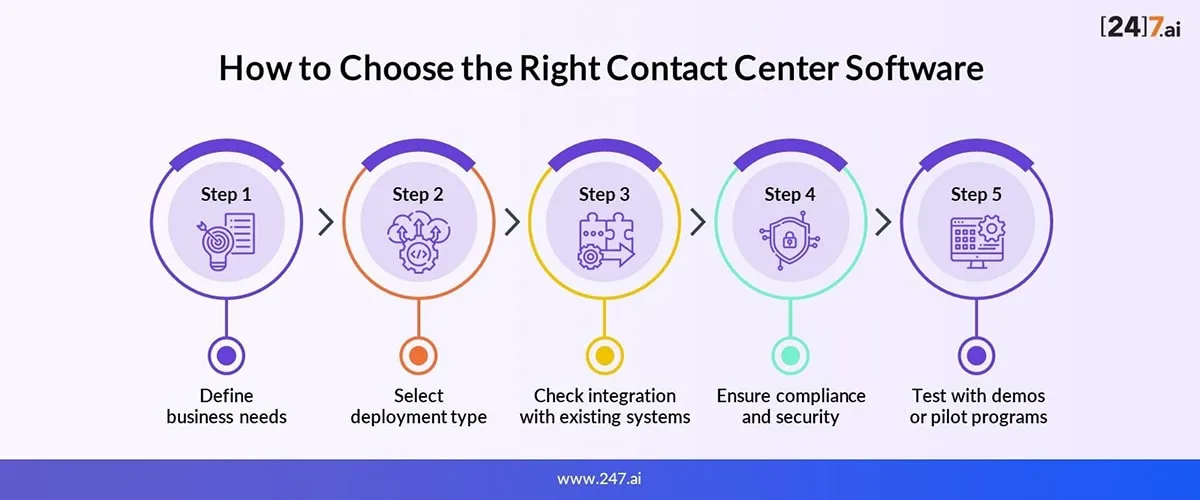Table of contents
- Introduction
- What Is Contact Center Software?
- Key Trends Driving Contact Center Software in 2026
- Core Features to Look for in 2026 Contact Center Solutions
- Benefits of Choosing the Right Contact Center Software
- How to Choose the Right Contact Center Software
- Common Mistakes to Avoid
- Future Outlook: Contact Centers Beyond 2026
- How [24]7.ai Helps US Businesses Transform CX
- Final Thoughts
- FAQs
Over the years, customer expectations have changed drastically. Traditional call centers, which mainly handle phone calls, are rapidly being replaced by AI-driven, omnichannel contact centers that deliver seamless, personalized experiences. Reflecting this shift, the U.S. contact center software market generated $10.5 billion in 2024 and is projected to reach $67.5 billion by 2033, highlighting the growing importance of advanced customer engagement platforms.
For U.S. businesses, selecting the right contact center software is now a critical strategy to stay ahead in customer experience, operational efficiency, and regulatory compliance.

What Is Contact Center Software?
It is the backbone of modern customer engagement. Unlike traditional call centers, which handle only voice calls, contact centers manage interactions across multiple channels, such as voice, email, chat, social media, and messaging apps.
Over time, these platforms have evolved from basic multichannel systems to omnichannel, AI-driven solutions that integrate analytics, workforce management, and customer data. Modern US businesses rely on contact center software to streamline operations, ensure regulatory compliance, and deliver consistent, high-quality experiences across all touchpoints.
Key Trends Driving Contact Center Software in 2026
Several trends are shaping the next generation of contact center platforms:
1. AI-Powered Automation
AI chatbots, voicebots, and predictive analytics are no longer optional. They handle repetitive queries, anticipate customer needs, and provide real-time insights, allowing human agents to focus on complex interactions.
2. Omnichannel Engagement
Customers expect seamless communication across channels. Modern software enables interactions via voice, chat, SMS, email, and social media, all integrated into a unified dashboard.
3. Cloud-Based Flexibility
Remote and hybrid work models require cloud-based contact centers for easy deployment, scalability, and secure access from anywhere in the US.
4. Regulatory Compliance
With stringent data protection laws such as HIPAA and PCI DSS, contact center platforms must ensure that sensitive customer data is securely handled across all channels.
5. Integrated Ecosystem
Integration with CRM, workforce management, and analytics tools is critical for optimizing agent performance and gaining actionable insights.

Core Features to Look for in 2026 Contact Center Solutions
When evaluating platforms, US businesses should focus on the following features:
- Omnichannel Routing & Unified Inbox: Seamless handling of customer queries across multiple channels.
- AI-Driven Analytics & Sentiment Analysis: Insights into customer mood and agent performance for continuous improvement.
- IVR & Self-Service Options: Quick resolution for common issues without human intervention.
- Workforce Engagement & Quality Management: Tools to monitor agent performance and optimize staffing.
- Scalability & Cloud Deployment: Ability to grow with your business and support remote teams.
- Security & Compliance Readiness: Built-in safeguards for regulatory requirements.
- CRM & ERP Integrations: Unified customer data for personalized experiences.
Benefits of Choosing the Right Contact Center Software
Investing in the right software brings tangible benefits:
- Enhanced Customer Experience: Faster, more consistent interactions lead to higher satisfaction.
- Operational Efficiency: Automation reduces repetitive tasks and lowers costs.
- Improved Agent Productivity: Unified dashboards and AI assistance enable agents to work smarter.
- Scalability: Adaptable platforms support growth without costly system overhauls.
- Data-Driven Decisions: Advanced reporting provides actionable insights for strategic improvements.

How to Choose the Right Contact Center Software
A structured approach ensures the best fit for your business:
- Assess Needs: Consider team size, remote capabilities, and customer expectations.
- Compare Deployment Options: Evaluate cloud, on-premises, and hybrid solutions.
- Evaluate Integrations: Ensure seamless connectivity with CRM, ERP, and other tools.
- Prioritize Compliance & Security: Confirm adherence to US regulations and standards.
- Run Pilots & Demos: Test the platform in real-world scenarios before full-scale adoption.
Common Mistakes to Avoid
Avoid these pitfalls when selecting software:
- Choosing based on price alone instead of features and scalability.
- Overlooking future growth requirements.
- Ignoring regulatory compliance needs.
- Skipping agent training and adoption planning, which can compromise ROI.
Future Outlook: Contact Centers Beyond 2026
The next wave of innovation includes:
- Generative AI & Advanced Automation: For more intelligent self-service and predictive assistance.
- Hyper-Personalization: Tailored interactions using customer data across channels.
- IoT & AR/VR Integration: Enhancing service delivery in connected environments.
- Predictive & Proactive Support: Anticipating customer needs before they escalate.
How [24]7.ai Helps US Businesses Transform CX
[24]7.ai empowers US businesses to leverage next-gen contact center software with:
- AI-Driven Automation: Chatbots and voicebots handle routine queries and provide predictive insights.
- Omnichannel Orchestration: Seamless customer experience across voice, chat, email, and social channels.
- Agent Assist Tools: AI insights enhance human performance, ensuring faster resolutions without sacrificing empathy.
By combining technology with human-centered design, [24]7.ai enables companies to maximize efficiency, satisfaction, and growth.
Final Thoughts
Choosing the right contact center software is a strategic investment for 2026 and beyond. It directly impacts customer satisfaction, operational efficiency, and compliance readiness. US businesses that adopt AI-powered, omnichannel platforms now will lead in both customer experience and growth.
Explore [24]7.ai’s solutions to evaluate, compare, and implement contact center software that aligns with your CX goals and future growth.
Frequently Asked Questions
Call centers handle only voice calls, while contact centers manage multiple channels with integrated analytics and AI-driven workflows.
Customers expect seamless interactions across all platforms; a unified approach ensures consistent service and loyalty.
AI assists with routine queries, predicts customer needs, and provides real-time insights for faster, accurate responses.
Yes, modern cloud platforms comply with HIPAA, PCI DSS, and other US-specific regulations for secure operations.
Track metrics such as average handling time, first-contact resolution, customer satisfaction scores, and operational cost savings.



